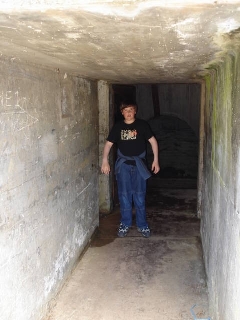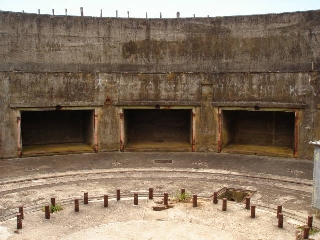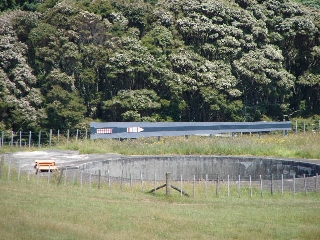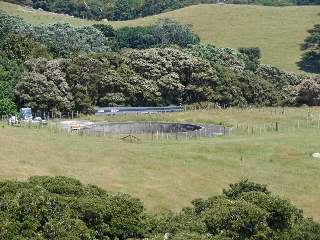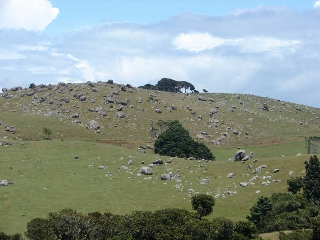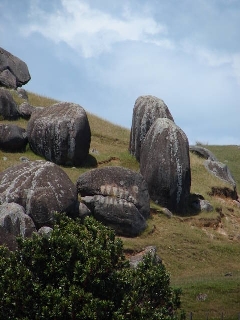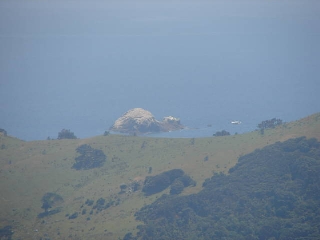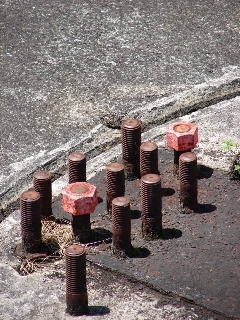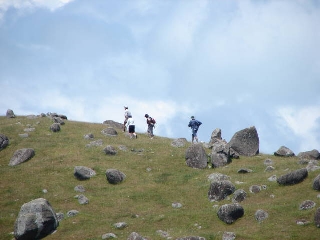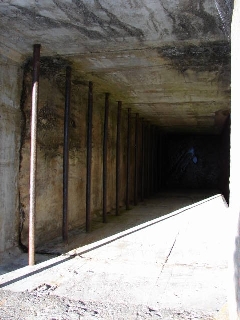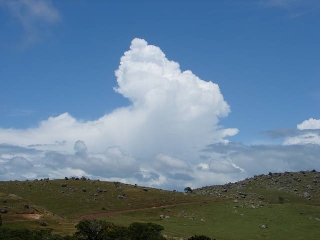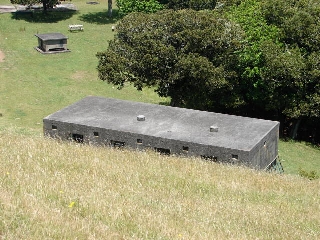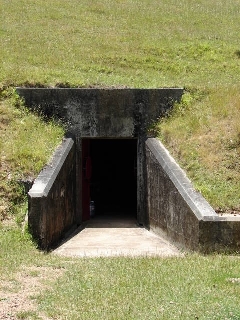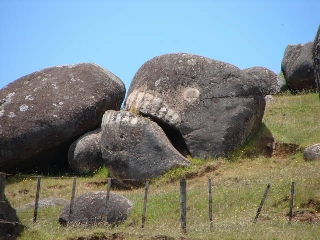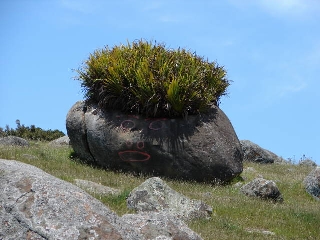Please show your support of Waihekepedia by adding a link to us from your web site. Waihekepedia T Shirts now available at the Ostend Market
Difference between revisions of "Stony Batter"
Hackademic (talk | contribs) |
|||
| Line 1: | Line 1: | ||
| − | Stony Batter is a privately-owned farm and | + | Stony Batter is a privately-owned farm and vineyard at the northeastern corner of the island. But the name is more widely associated with an extraordinary complex of tunnels connecting defensive gun emplacements built during World War II and which are now part of a Department of Conservation reserve. The gun emplacments are one of the island's most famous tourist attractions. It;as also famed for its widespread andecite rocks and boulders. |
| − | |||
| − | Stony Batter was of part of a counter bombardment battery system progressively being installed in the Hauraki Gulf from the 1930s. Composed of various gun batteries, such as at Whangaparaoa, Motutapu Island and at Stony Batter, as well as having observation posts such at Rangitoto Island (command post) and Tiritiri Matangi Island, it was supposed to engage enemy naval forces entering the inner gulf. Ranges would have been to far beyond the line of sight (over 30 km, thus the need for a complex set of observation points and communication lines), | + | In an [http://en.wikipedia.org/wiki/Stony_Batter extensive piece], Wikipedia says: "Stony Batter was of part of a counter bombardment battery system progressively being installed in the Hauraki Gulf from the 1930s. Composed of various gun batteries, such as at Whangaparaoa, Motutapu Island and at Stony Batter, as well as having observation posts such at Rangitoto Island (command post) and Tiritiri Matangi Island, it was supposed to engage enemy naval forces entering the inner gulf. Ranges would have been to far beyond the line of sight (over 30 km, thus the need for a complex set of observation points and communication lines), as well as at least initially beyond the range of most enemy ships ability to retaliate." |
While approved in 1939, construction was delayed for cost reasons until German raiders in New Zealand waters during 1940-1941, as well as the war entry of Japan in late 1941, suddenly turned it into a high priority project. In 1942 the site on Waiheke was chosen, but it took until early 1943 until the Public Works Department was finally tasked with construction after other contractors declined the job. Delays were faced by the remote location which at first had no road access, and also by the fact that the project was kept in strict secrecy, requiring with a large degree of self-sufficiency during the construction period, complete with its own living facilities and machine shops. The new battery was generally referred to only as A2, to conceal its location.[2][5] | While approved in 1939, construction was delayed for cost reasons until German raiders in New Zealand waters during 1940-1941, as well as the war entry of Japan in late 1941, suddenly turned it into a high priority project. In 1942 the site on Waiheke was chosen, but it took until early 1943 until the Public Works Department was finally tasked with construction after other contractors declined the job. Delays were faced by the remote location which at first had no road access, and also by the fact that the project was kept in strict secrecy, requiring with a large degree of self-sufficiency during the construction period, complete with its own living facilities and machine shops. The new battery was generally referred to only as A2, to conceal its location.[2][5] | ||
Revision as of 02:31, 23 August 2007
Stony Batter is a privately-owned farm and vineyard at the northeastern corner of the island. But the name is more widely associated with an extraordinary complex of tunnels connecting defensive gun emplacements built during World War II and which are now part of a Department of Conservation reserve. The gun emplacments are one of the island's most famous tourist attractions. It;as also famed for its widespread andecite rocks and boulders.
In an extensive piece, Wikipedia says: "Stony Batter was of part of a counter bombardment battery system progressively being installed in the Hauraki Gulf from the 1930s. Composed of various gun batteries, such as at Whangaparaoa, Motutapu Island and at Stony Batter, as well as having observation posts such at Rangitoto Island (command post) and Tiritiri Matangi Island, it was supposed to engage enemy naval forces entering the inner gulf. Ranges would have been to far beyond the line of sight (over 30 km, thus the need for a complex set of observation points and communication lines), as well as at least initially beyond the range of most enemy ships ability to retaliate."
While approved in 1939, construction was delayed for cost reasons until German raiders in New Zealand waters during 1940-1941, as well as the war entry of Japan in late 1941, suddenly turned it into a high priority project. In 1942 the site on Waiheke was chosen, but it took until early 1943 until the Public Works Department was finally tasked with construction after other contractors declined the job. Delays were faced by the remote location which at first had no road access, and also by the fact that the project was kept in strict secrecy, requiring with a large degree of self-sufficiency during the construction period, complete with its own living facilities and machine shops. The new battery was generally referred to only as A2, to conceal its location.[2][5]
The tunnels and underground chambers were quarried by hand, with formwork for the walls and ceilings then filled with concrete (reinforcing steel was not used due to shortages). Aggregate was obtained from the prominent rocky outcrops giving Stony Batter its name. The tunnels and chambers where designed based on plans of the Tawa Flat Railway Tunnel project. The work on the installations, sans guns, was completed behind schedule in 1944, and had by then ballooned from initial estmates of £140,000 to £327,966, excluding the costs of the guns. Construction of the battery was however considered a major feat of engineering, carried out under particularly difficult circumstances. As the tides of war turned, only two guns were installed, one in 1944, and one in 1948. The third gun was cancelled before shipment. Never fired except for testing and training purposes, the guns were dismantled and sold for scrap in 1961.[2]
The battery is now in the hands of a preservation society, which keeps it open for the public under a concession from DOC. The preservation society is currently trying to source an appropriate artillery piece to restore at least one gunpit to a similar state as it would have appeared in late WWII.
Characteristics
Layout of tunnel system.The 9.2 inch guns that were once installed in two of the gunpits had ranges of 31,300 yards (over 30km) and a possible rate of fire of one round per minute.[2] This made them the largest guns ever used in New Zealand.[5] Their mountings could swivel them 360° and elevate up to 35°. They were served by ammunitions storage lockers in the base of each gunpit, which were in turn fed by large electric hoists from underground ammunition dumps.[2]
Next to the gunpits, which can be accessed at any time, the site also contains around a kilometre of tunnels, most of which are accessible by guided tour. These connected the gunpits with each other and with their ammunition stores, a plotting room, an engine room providing electricity, as well as with store rooms and barracks (located aboveground).[2]
